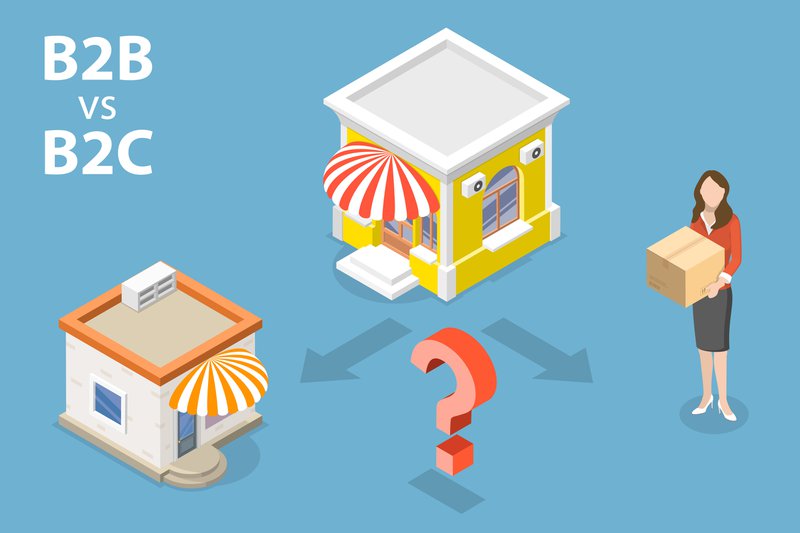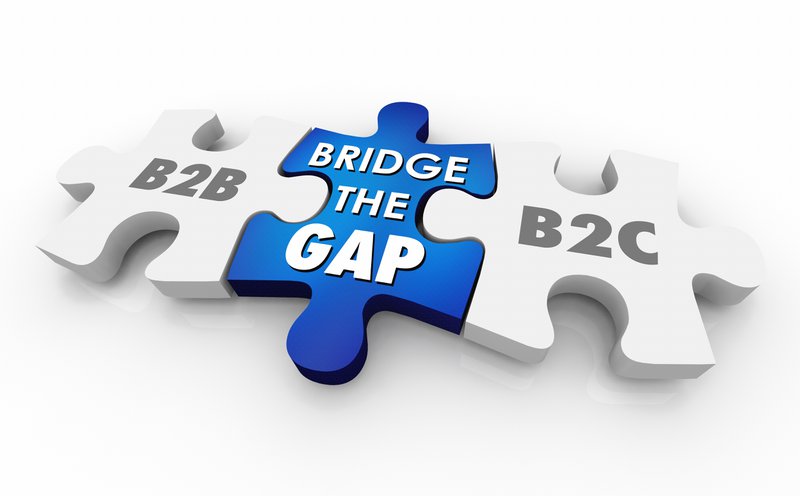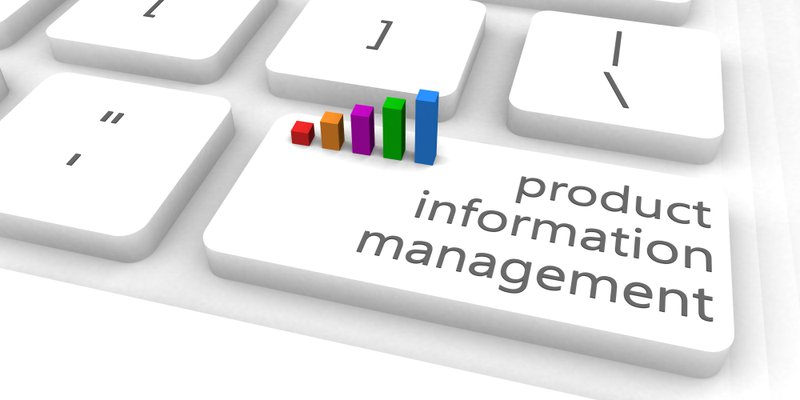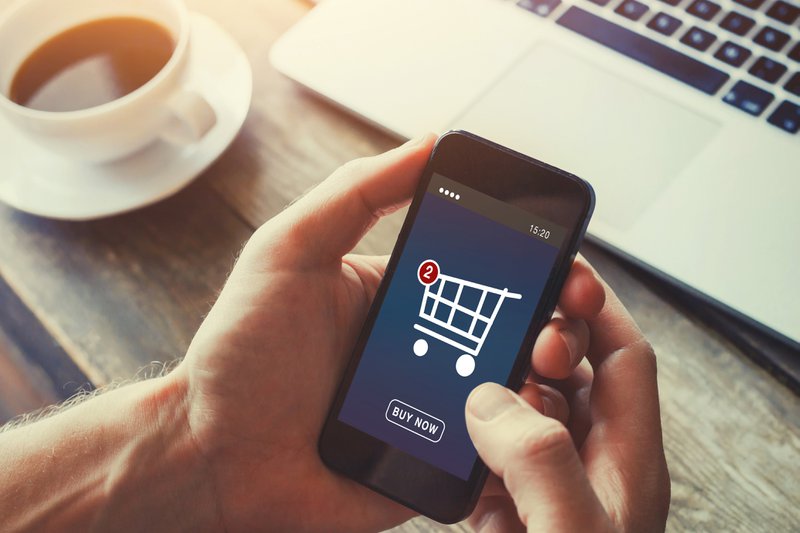Business-to-business (B2B) eCommerce sites have traditionally focused on providing practicality to customers, compared to the highly personalized demands of the business-to-customer (B2C) end-user. There’s a shift taking place in the nature of B2B commerce, however. Today’s B2B customer expects a friendlier, more targeted user experience, resembling B2C delivery.
What Makes B2B Commerce and B2C Different?
The most fundamental difference between the two modes of sales lies in the name. Business-to-business (B2B) sales comprise companies that sell to other businesses (though will sometimes also sell to consumers if asked). Meanwhile, business-to-customer (B2C) sales bypass middlemen and sell directly to end-users.

Because businesses have different needs than direct consumers, B2B sales traditionally require a different touch than B2C. B2B commerce adapts to the individualities of other businesses’ approaches to purchasing decisions, marketing, the value of orders, customer lifecycle, and order fulfillment, among other factors.
B2B vs B2C Commerce: Different Purchase Intentions
B2C and B2B shoppers approach commerce with different intents, and it’s important to understand these intents in order to make a compelling pitch. B2C consumers generally make numerous small purchases, are comfortable with inexpensive impulse buys, and focus heavily on brand loyalty. In turn, they expect a fast, easy eCommerce checkout experience. B2C websites, therefore, focus heavily on a design that encourages upsells.
Meanwhile, B2B sales focus on practicality, large orders, and carefully considered value. The global B2B commerce marketplace value is substantially greater than the B2C market, due to average order values that can run nearly seven times larger than their B2C counterparts. Considering the exorbitant sums spent, B2B shoppers also take much longer with orders, conducting extensive research. B2B customers rarely make impulse buys, as they require stakeholders to sign off on every order.
Each purchase is weighed against the company’s return on investment (ROI), requiring justification and thus leading to longer purchase cycles. Thus, B2B businesses serve fewer customers, but with larger orders and bigger accounts.
The buying cycle of a B2B commerce customer often runs years longer than B2C, with more direct sales, contract reviews, price negotiations, service agreements, and customer support throughout. All of these interactions pass through numerous team members for approval after competitive analysis and discussion with stakeholders.
When it comes to aesthetics, B2C users expect rich content with buying guides, videos, and social indicators, where B2B sites are traditionally more utilitarian. Since B2B buyers often place the same orders month after month, they want easy-to-use tools, efficiency, and minimal distractions.
Differences in B2B Commerce Advertising
Because of the differences in where their respective customer bases are, advertising strategies also differ for each category. B2B commerce drives lead generation primarily through landing pages, social media posts, and blogs online; it also makes heavy investments in offline activities like trade shows and onsite demonstrations. Meanwhile, B2C invests more in TV ad spots and other mass advertising.
B2B also hinges on personalized, 24/7 engagement and support. Marketing is needs-based, for customers that follow tight purchasing parameters. B2B email marketing campaigns focus on informative, educational content; B2C focuses more on offering specials focusing on targeted products and impulse buying behavior.
While branding is important in both contexts, B2B websites tone down the branding hype, focusing on consistency with a subtler presence targeting a narrower audience. B2C takes the opposite approach, with more eye-catching branding and a diverse range of branding styles based on wider demographics.
B2C Features You Should Have In Your B2B Ecommerce Website
B2B commerce comes with unique eCommerce challenges, but shoppers today expect the same personalized standards found in current B2C models. Today’s B2B eCommerce websites must focus on subtly showcasing their brand’s unique qualities, and building personal connections with customers throughout the purchasing process.

Powerful Product Search Functionalities
The modern B2C consumer has a near-flawless search experience through sites like Google and Amazon. B2B users have come to expect this as well, meaning that companies need to adopt B2C best practices, focusing on their on-site search usability, in order to remain competitive.
These shoppers also expect features exclusive to web-based B2B commerce, like the ability to mass upload complete shopping lists through CSV or Excel files, bringing up SKUs and generating quick orders.
B2B websites are replete with huge catalogs of products, each with detailed descriptions, SKUs, and variations. Search features that meet the challenge require machine learning and artificial intelligence (AI) to help run user analytics and optimize individualized searches. This may seem like a lot of work, but the results are worth it! A B2B company with a highly efficient search functionality can expect more conversions, more revenue per session, and increased page views and length of time per visit.
Advanced B2B search processes also should consider the importance of alternate word searches, displaying relevant items based on past purchases, ordering search results based on history, and adding item previews—but this is only the start. A fully integrated system will also have back-end details on stock, so searches can include stock availability and unit prices at wholesale, retail, individual, and bulk rates.
Including frequently asked questions (FAQ) pages also allows B2B shoppers to research products at the exact point they are looking for them. More advanced searches might integrate further valuable filtering and navigation options, including category search, sorting, and discount search.
Detailed Product Information and Content
Merging product data with marketing material, product information management (PIM) processes are critical for eCommerce businesses. PIM helps to centralize product details across the entire business pipeline, from catalogs to the public-facing eCommerce website.
PIM ensures that everyone involved in every business connection—wholesalers, manufacturers, resellers, distributors, all partners, suppliers, agencies, and marketplaces—has accurate info. Once you enter PIM data in one format, product updates automatically update across all shared data locations, eliminating redundant manual entry. This also then allows machine learning to more accurately target upsells.
While PIM brings necessary efficiency across the sales pipeline, it also calls for long hours of manual data entry. But the benefits of a centralized product data compilation are immeasurable.

Checkout and Order Features
According to data from Statista, customers abandon nearly seven in 10 digital shopping carts (69.8%) without completing a purchase—a number on the rise with each passing year. An online sales process that doesn’t end in a checked-out cart is no success at all! Obviously, enhancing the customer check-out experience is imperative for businesses looking to succeed.
There are a few basic standards that B2B customers have come to expect from their eCommerce check-out experience. When B2B sites take time to integrate features specific to their clientele, they ensure retained loyalty.
For example, B2B buyers prefer to pay by invoice. In fact, 82% of B2B buyers would choose a vendor over others if said vendor offered invoicing at checkout with 30-, 60-, or 90-day payment options. This might also include a “buy now pay later” (BNPL) feature at checkout.
Consider the Following When Upgrading Your B2B Commerce Checkout System
- Buyers like having multiple ways to sign in quickly. Facilitate this by letting customers sign in with their existing email or social media accounts, to spare them the effort of crafting unique usernames or passwords.
- Offer ways for shoppers to multiple-select items for the shopping cart, instead of adding one item at a time.
- Offer multiple electronic payment options.
- Add logical, AI-based cross-sell and upsell suggestions.
- Offer live 24/7 customer support.
- Customers like transparency and honesty, so make all fees clear.
- Include auto-fill in the checkout process to reduce shopper exertion.
- Adding a progress bar/meter graphic to the page helps encourage the user to complete the sale.
- Offer easy ways for shoppers to track their order, and automatically send confirmation texts or emails.
Finally, a vital priority for every B2B website is protecting user security, to prevent identity theft and fraud.
Must-Have Features for B2B Ecommerce Websites

For years, B2B eCommerce platforms have used pre-formatted, template-based websites. Despite the diverse range of products and demographics of interest, businesses spend little time optimizing and specializing their site’s specific users.
Now that customers of B2B commerce expect a B2C experience, it’s time to make those important website upgrades, simplifying the buying process and taking advantage of features that can set you apart. Consider the following features near-essential in today’s B2B commerce landscape.
Contract Pricing
Contract pricing is the purchase price that a B2B company and a customer have agreed on. It’s important to find a way to accommodate such special pricing on your site, whether with discounts applied by percentage or by specified dollar amounts. This can integrate into every category and individual product in the system, shared with the sales team, so they know what cost parameters they can negotiate.
B2B commerce sites also need prices for wholesale margins, targeting values for specific user accounts, and offering bulk/quantity discounts. This might include flat prices, tiered levels based on quantity or contract, and other dynamic pricing based on business preferences—for example, lower costs for longer shipping times.
Cost-Plus Pricing
Cost-plus pricing is a way to factor in profit without necessarily doing deep research on customer preferences or competitors. In the simplest terms, cost-plus is taking an item’s cost, adding a set mark-up percentage, and multiplying these numbers to establish the selling price.
Other Flexible Pricing Models
Competitive pricing strategically establishes one’s brand against competitors by researching market prices and targeting the lowest one. This is risky, as it might not allow the right margins for the product and business model. It’s also not the most accurate way to gauge the actual value of products or brands.
Value-based pricing entails researching shopper data to base prices on how customers rank the value of various products. You can further adjust prices to push lower-value items, with more profitable margins on items that hold a high customer value.
You also might customize pricing based on customer loyalty. Similar to value-based pricing, you can manipulate this according to brands/products and their corresponding features. For example, you might price items with more features or better competitive qualities in the same field accordingly.
B2B commerce sites can use a membership model, create limited-time offers, and test out other pricing models—once you’ve centralized your main system. The more flexible the integrations, the easier it is for a company to experiment with pricing models, using research to implement the most profitable results.
Live Customer Support
In a time where B2B and B2C customers alike expect constant, individualized attention, world-class customer service is essential for any eCommerce company. But while everyone appreciates a fast response, it’s quality that matters most in B2B sales, not just speed. Statista data finds that 39% of B2B customers cite a knowledgeable customer service representative as one of the most important support qualities.
Customers just want to feel heard at the end of the day, and this accommodation can make a world of difference for your operations. Seventy-seven percent of shoppers say they hold a more favorable view of a business when they see their feedback recognized and implemented. To the same degree that live support can drive sales, customer feedback also provides priceless research for your future operations.
Around-the-clock live chat support is one of the easiest ways you can up your customer service game. This allows customers to feel heard no matter when they have a query. And depending on the breadth of your B2B market, it might also help you accommodate customers in far-reaching time zones as well.

However, it is critical to consider how you deliver this 24-hour support. Some sites lean heavily on a dynamic system similar to frequently asked questions (FAQs). This is a great way for people to get answers to common questions; however, weightier or more nuanced concerns that might determine a sale go unanswered, since the question isn’t logged in the database.
Similarly, it’s important that automated systems don’t stymie user accessibility to live help in one form or another. If customers feel relegated to an unending line of ticket-holders, they are likely to take their business to your competitor.
Meanwhile, talented, knowledgeable people will not let your company down, when it comes to customer support, whether it’s through audio or video support, live chat, or in person.
Real-Time Inventory Visibility
As B2B eCommerce expectations grow more exacting, today’s customer evaluates every part of their website experience. From the moment the first page loads to the order tracker after they’ve paid, they’re watching every second of the experience carefully. Thus, every stage of a company’s supply chain provides an opportunity to improve customer experience.
Inventory visibility is about the interconnection of every channel in an eCommerce website. Accounting management, warehouse communications, updating SKUs and details, keeping accurate counts of item availability on public-facing sites—all of this hinges on inventory visibility.
When a site only integrates shared information for parts of a business, inventory details can easily fall out of sync. This means that what appears available on the company website may not actually be in the warehouse or in transit.
Instant, up-to-date inventory status doesn’t just align every part of your business for obvious practical reasons; it also helps you forecast accurate future data about your products. This transparency also makes for an enhanced customer experience, as customers can see up-to-date information all the way through checkout. They can back-order unavailable items, or choose not to create a partial order based on real-time data.
All shoppers, especially B2B shoppers, like to operate with all the facts at hand. And yet, only 38% of retailers show their real-time inventory availability on their product pages. The more information you can provide customers, the more you’ll set yourself apart from the competition.
Reorder and Quick Order Features
B2B purchasing is a unique experience from B2C: orders tend to run far larger, with monthly re-orders and other customizations the average personal shopper does not need. Reorder and quick order features are a perfect way to meet your B2B shoppers where they are, showing that you understand their specific needs.
Consider a simple subscription-based reorder system, to streamline both your shopper and your own experience while allowing for a range of flexibility. You can use account data, user inventory needs, and other customer behavior to customize reorder features tailored to clients’ exact needs—a must in a hyper-personalized B2B era.
Previous discussions about inventory visibility come in handy here again. A customer who reorders the same items frequently would greatly appreciate knowing about low stock, so as to not be surprised when their order arrives incomplete next month due to inaccurate stock.
High volume, recurring B2B customers also want the benefit of quick order features. This includes the ability to import order lists using CSV or Excel files, complete with product SKUs. They want the ability to place orders from an uploaded list and save these previous orders for future purchases. The more options you provide to simplify ordering, the more sales you’ll see.

Future-Proofing Your B2B Ecommerce Site: 3 Things to Consider
As we become an increasingly online society, it’s clear that B2B eCommerce businesses have two options: update websites to meet the high standards users expect or fall behind their competitors. Customers are more selective and savvy than ever. They’re more difficult to sway through traditional methods, meaning salespeople face new challenges to influence their purchase decisions.
Most users find B2B purchasing processes too complex to handle on their own. While buyers spend less time building direct connections with suppliers than in the past, those who receive guidance are nearly three times more likely to have a smooth purchasing experience. Thus, B2B commerce sites need to balance training an educated sales force, with future-proofing and enhancing their site. Quick responses, sophisticated searches, AI, and other cutting-edge features are now a must in this emerging, digital market—as is an informed live team to shepherd clients along.
What can you do to future-proof your B2B business today?
1. Align and Refine Your B2B Sales Process
The evolving nature of sales funnels, email campaigns and general product knowledge means bridging the gap between marketing and sales reps is more complicated than ever before.
Traditionally, a company’s marketing team attracts new prospects. They then forward promising prospects to the sales team, which is trained to close the deal on a sale and then nurture long-term relationships. However, today’s sales have blurred these lines, merging the many steps between marketing and sales. This results in sales reps being under-equipped to deliver content effectively, and a marketing team bereft of valuable data to build compelling collateral.
Even though today’s tech allows for teams to automate much of the sales process, there are some spots where only a personal, human touch will do. It is vital for businesses to recognize how to best invest in training sales reps to complement an advanced technology, rather than adding one more confusing layer to the mix.
In order to generate strong leads, both sales and marketing need to stay aligned in their messaging. Software-driven sales funnels, the marketing team, and sales reps must all be equally knowledgeable about products and processes. A unified message, consistent throughout the sales process, is above all what captures the trust and interest of new accounts.
2. Follow B2B Ecommerce Website Design Best Practices
Closing a sale also requires a well-designed website—one that is easy to navigate and reflects the values of its customers. Your website is your company’s digital face, and first impressions matter. Thus, a quality B2B eCommerce web design is an easy route to higher conversion rates.
How can you enhance your site design? For starters, use a format that will respond across devices. Shoppers increasingly make their purchases on the go, from their handheld devices. Thus, it’s important to design a site that performs the same on mobile devices as on a desktop. Whether someone visits your site on an iPhone, an Android, a tablet, or a computer, you want your site to meet their needs.
But it’s not just enough to make sure your site functions the same across devices. You need to ensure that this equal access drives customers to a site that looks good and loads well. Everything from the colors scheme to site navigation should follow a planned, intentional guide, with your ideal customer in mind. No matter how complex the underlying products, inventory, and back-end office may be, your site should be easy, quick, and logical to navigate.
A well-organized site will guide the user in the direction you want them to go: from valuable information and rich, relevant visuals, to product catalogs and then to details, ultimately landing at the shopping cart page and checkout. All of these pages and images should load fast, no matter what. Scatter relevant images throughout lengthy content pages, and optimize them for fast loading by compressing the file sizes.
Your site also needs a robust search system, using datasets from product content, flyers, brochures, and marketing materials. Provide customer accounts with saved order histories to encourage repeat sales and simplify recurring purchases.
3. Anticipate Further Changes From Newer Generations

Millennials and Gen Z consumers continue to age, and the concerns and peculiarities of these digitally native generations will reshape sales accordingly. In fact, one survey found that as of 2016, Millennials already dominated 73% of B2B sales. Imagine how much more of the B2B commerce market these younger generations occupy now! As these shoppers come to dominate the business-end of sales as well as the consumer-end, B2B will have to adjust to meet their needs.
For example, data seems to suggest a preference among Millennials for practical knowledge, as opposed to thought leadership content. Similarly, younger generations seem to take toward case studies and video content, instead of lengthy papers and webinars.
To understand these swings, it helps to understand the circumstances in which these generations grew up. Millennials and Gen Z were both formed in the wake of the 2008 financial crisis and catastrophic recession. The precarious, unequal recovery from this economic calamity was then yet again upended by the Covid-19 pandemic and an accompanying inflation spiral and burgeoning second recession. These generations are no stranger to economic turmoil, and as such are highly discerning customers. Additionally, younger Millennials and Gen Z are the first truly digitally-native customers, meaning they’ve never lived in a world without the internet.
Considering all of this contextual information, the takeaway should be that Millennials and Gen Z are resilient buyers. They don’t respond to traditional marketing approaches; They use ad blocks, are generally guarded, and have a keen nose for sales-y or phony advertising.
The way to reach them, then, is by focusing on real connections and educational marketing. Websites need to run at peak performance for these savvy shoppers, with fast-loading pages, relevant content, and an exhaustive knowledge base. When they’re ready to ask questions, they’ll reach out for reps or support.
Optimize Your Website for the Future of B2B Commerce
B2B eCommerce is fundamentally different from B2C, and likely always will be. The two avenues service distinct clientele bases with unique needs. However, as technology and generations change, many B2B sales leaders are finding that their own market is starting to evolve—and they have to change to keep up with it. As B2B shoppers come to expect more robust features commonly found in B2C sales, businesses must adapt quickly to keep at the head of the market.
One of the best ways to do this is by overhauling your eCommerce platform to match the digital era we’re in. You need a platform that functions across a range of interfaces and delivers fast load times and appealing visuals in every modality.
eCommerce software developer, Zobrist, crafts solutions with an eye toward the future of B2B sales. To transform your site into a B2B industry titan, you need the right strategic development partner. Reach out to Zobrist today and let’s see how we can prepare your business to meet the future of eCommerce.




